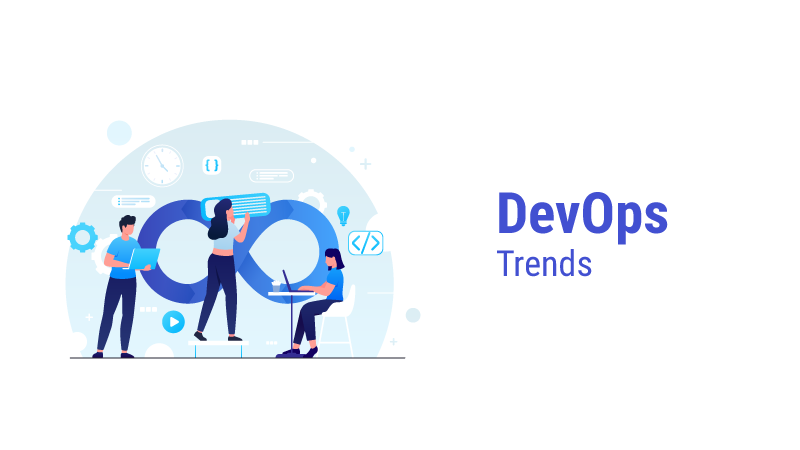DevOps Trends to Look Out for This Year

The way the COVID-19 pandemic has affected businesses and people has been concerning and every sector was trying to cope with the devastating impact which will still be felt in the years to come. Another big takeaway for the IT industry is the way technology has played a major role in bringing back the entire working community to continue work, accept services, learn, and interact socially.
This has created more opportunities for developers and DevOps professionals as they have got to focus on regular improvements and innovations together. DevOps is a combination of development and operations and has become very popular with consistent growth since 2009. Here, in this article, you will get to know more about the constantly changing DevOps trends that have emerged as innovative technologies.
Major DevOps trends
With the increased dependence on technology, major trends like DevOps have become popular among businesses. Here are some of the DevOps trends to look out for this year 2023.
Microservices architecture growth
In a microservices architecture, applications are divided into individual units thus offering greater flexibility to bigger teams. When compared to self-contained monolithic applications, microservices architecture gives better scalability and agility to enterprises once they are deployed successfully. Developers can scale these individual units to suit the needs of the business instead of trying to scale a whole application at once. In addition, micro-services make it easy to cover issues without interrupting the entire application if something goes wrong.
Microservices are gaining power in 2023 along with serverless computing. Poor implementation of microservices can invite a lot of risks including security issues, data loss, and poor reliability.
Introduction to low-code tools
Low code development is the process of creating high-quality applications for coding with minimal effort. It is best suited for sudden business offerings and the market for low code is also increasing. The integration of Low Code Development and DevOps will facilitate coordination between teams and accelerate development. This will create a user-friendly interface and enable developers to make the best use of modern technology tools. With a Low-Code Development Platform, developers can easily build applications by utilizing a drag-and-drop interface and graphical user interface (GUI).
Going serverless
One of the leading and logical DevOps trends recently adopted by DevOps is going completely serverless. DevOps’s new serverless frontier in the architecture market is vastly projected to new standards and greatly reduces infrastructure costs. Efficiency and reliability are the two biggest advantages of serverless computing. Eliminating the responsibility of users in the management and functioning of infrastructure and enabling users to execute the code as needed in response to requests or event triggers are the main advantages of serverless computing over traditional cloud automation models. With the use of serverless architecture, developers can eliminate the risk of potential maintenance issues with traditional frameworks.
Enablement of Kubernetes
Kubernetes is a kind of container orchestration tool and is also known as K8s. It helps in sharing different software and applications associated with the IT operations team, thus making it easier for developers. There is a great deal of impetus for efficiency in choosing the Kubernetes workflow. Moreover, it makes it easy to test, develop, and deploy pipelines on DevOps.
DevOps security
Security is always an important aspect of every business. With a huge number of the remote workforce working from home for the last two years with enormous potential for the future, businesses have started to realize that a secure software distribution network is not just an option but a serious prerequisite.
DevOps Security, or DevSecOps is a set of tools that combines software development (Dev), IT Operations (Ops), and Security (Sec) together to enhance the ability of an organization to distribute services and applications securely at high speeds. The way security in the IT department needs to be attained has been changed by DevOps. As the transition from the long-term deployment of monolithic applications to active development environments, security has to be integrated highly into functional and development processes. DevSecOps begins with development life cycles that are secure and security patterns defined for services and applications and ends with automated security for automated operations.
Integration of Infrastructure as Code (IaC)
Infrastructure as code is the basic principle of DevOps in cloud locations. Everything including the storage devices, on-premise or in the cloud service networks – all falls under the term “code” which allows businesses to automate and simplify infrastructure. Moreover, the IaC is going to provide an elementary infrastructural version control system. Therefore, using code and DevOps infrastructure can result in faster recovery and minimal downtime. It is easy to automate by converting every storage, network, server, and database into lines of code. Additionally, it facilitates easy rollback and recovery using version control. Well, it’s very risky to implement, and you may have to implement configuration management systems.
Supporting chaos engineering
Chaos engineering comes under DevOps which allows software testing in production to be more resistant to unexpected problems or issues that may not be identified by other testing methods. The process aims to break down the system in order to detect flaws and strengthen every vulnerable link in the system. The entire approach is to help developers identify all possible threats and eliminate attacks that could interfere with the product’s performance in the real world or misuse of user data. Although there are many tools available to assist developers with the technique, implementing the practice in an exact way is very important. Therefore, QA and developers are advised to remain coordinated while working on the whole concept of identifying system vulnerabilities through effective research and development.
Chaos engineering, in this context, has proven to be the highest quality fourth or fifth-level discipline covered in the set of DevOps practices. You need to follow certain points to implement chaos engineering:
- Understand and detect gaps and vulnerabilities in a system.
- Fix the standards for the system to follow.
- Perform tests, research, and make improvements.
Wrap Up
Here in this article, we have discussed the recent DevOps trends to look out for this year. DevOps has been growing as one of the most anticipated trends that are going to change the future of the IT industry as a whole. One can reap many advantages through the combination of potent and logical DevOps solutions. It should be noted here that the business requires experienced DevOps developers to support the upcoming DevOps services. The goal is to bridge the gap between development and functions while promising the growth of your business using technologically advanced solutions.
Get Started with our Custom Software Development ServicesBlogs by Category
AppForms Artificial Intelligence Blockchain Call Centers Chatbots Cloud Computing Data Management Design Digital Marketing Digital Transformation Enterprise Applications FinTech Insights LowCode Development Microsoft Mobile Apps News Office 365 Robotic Process Automation Security SharePoint Software Development Web Application7 Essential Tips to Reduce Technical Debt

2023-10-19 14:10:27